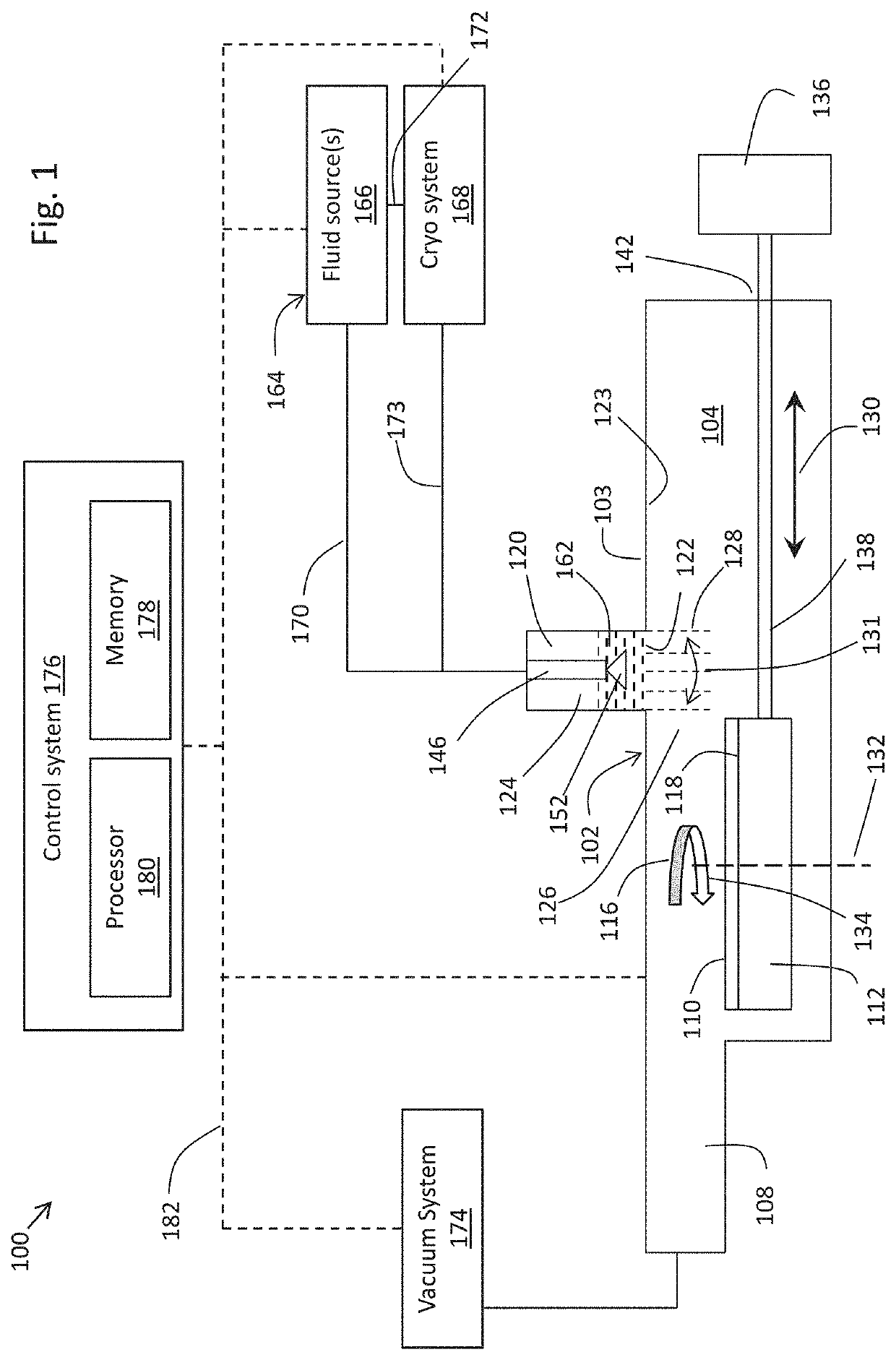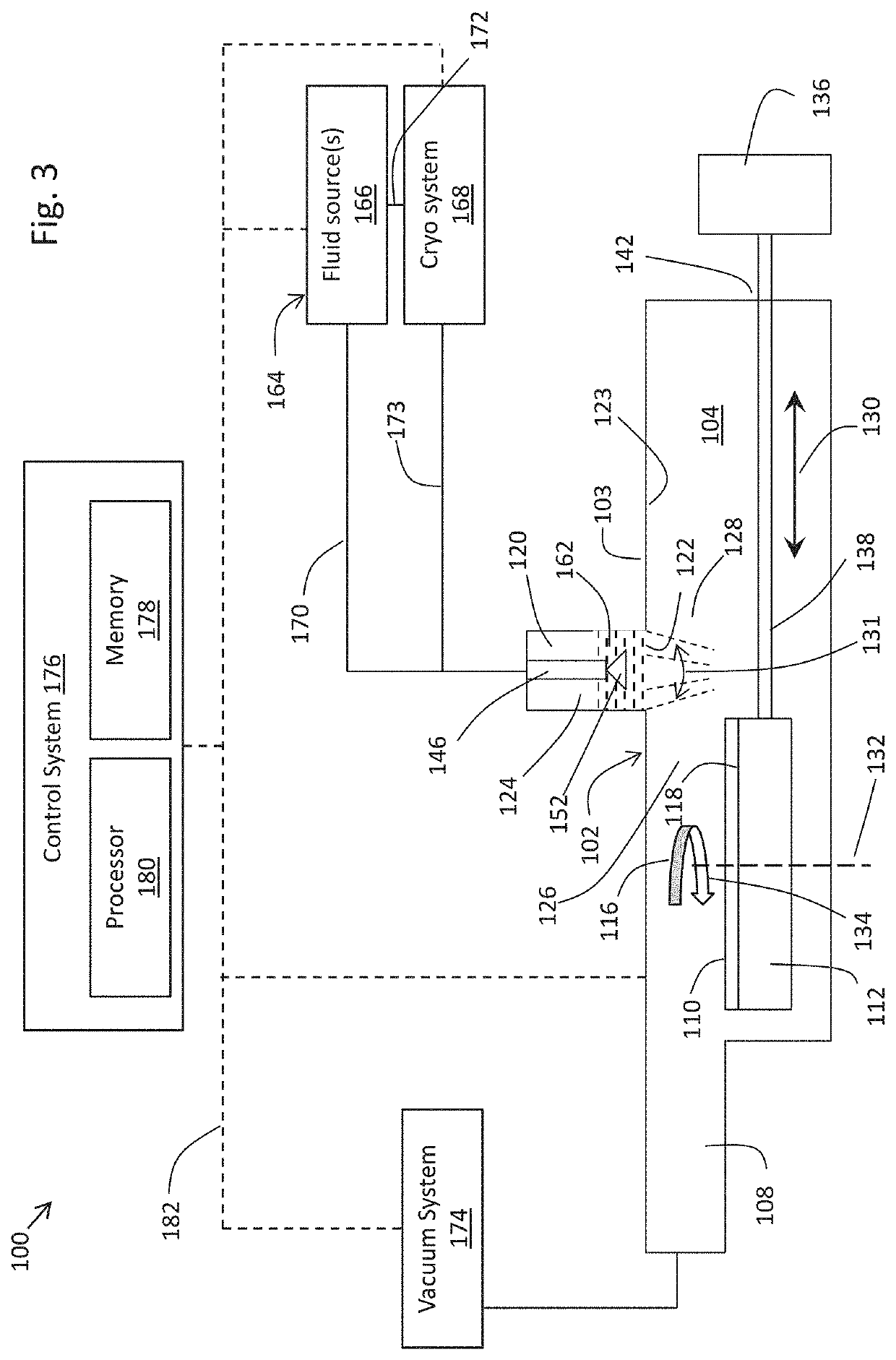Microelectronic treatment system having treatment spray with controllable beam size
a microelectronic treatment and control beam technology, applied in the direction of cleaning process and apparatus, cleaning of flexible articles, cleaning using liquids, etc., can solve the problems of difficult to provide, cryogenic treatment, and less practical scanning nozzle in cryogenic tools
- Summary
- Abstract
- Description
- Claims
- Application Information
AI Technical Summary
Benefits of technology
Problems solved by technology
Method used
Image
Examples
example 1
[0083]Referring to FIG. 5, tests (Tests 1 and 2) were conducted to demonstrate small particle cleaning of a 300 mm, bare silicon wafer 200 having a surface 201 contaminated with 30 nm silica particles and then exposed to cryogenic aerosol treatment beams at two different chamber pressures, respectively. A relatively more concentrated treatment beam at relative higher vacuum chamber pressure of 19 Torr was used for one test. This was compared to a larger, more diffuse treatment beam at lower chamber pressure of 4 Torr under otherwise the same conditions for a second test.
[0084]To prepare the wafer for testing, 30 nm silica particles were wet deposited onto the bare silicon wafer 200, aged for 3 hours, and then placed into a vacuum chamber in a cryogenic treatment tool according to FIG. 1 and FIG. 4. The tool was configured to have, the capability to control the chamber pressure. A nozzle was mounted in a cylindrical auxiliary chamber such that the nozzle orifice was 50 mm from the su...
example 2
[0092]Tests were conducted to evaluate how flow rate and chamber pressure impact the shape and size of fluid treatment beams used to clean particles from wafer surfaces. The tests were conducted using a 300 mm, bare silicon wafer having a surface contaminated with 30 nm silica particles. The contaminated wafer was exposed to fluid treatment beams in four different tests (Tests 3, 4, 5 and 6) using the conditions reported in Table 2-1.
[0093]To prepare each test wafer for testing, 30 nm silica particles were wet deposited onto the bare silicon wafer 200, aged for 1 hour, and then placed into a vacuum chamber in a cryogenic treatment tool according to FIG. 1 and FIG. 4. The tool was configured to have, the capability to control the chamber pressure. A nozzle was mounted in a cylindrical auxiliary chamber such that the nozzle orifice was 50 mm from the substrate. The nozzle orifice was 0.0925 inches (2.35 mm) in diameter. The nozzle also was recessed 27 mm within the cylindrical auxilia...
example 3
[0101]Tests were conducted to evaluate how flow rate, nozzle orifice size, and gap distance (shown as gap distance 126 in FIG. 4) impact the shape and size of fluid treatment beams used to clean particles from wafer surfaces. The tests were conducted using a 300 mm, bare silicon wafer having a surface contaminated with 100 nm silica particles. The contaminated wafer was exposed to fluid treatment beams in three different tests (Tests 7, 8 and 9) using the conditions reported in Table 3-1. For all three tests, pressurized and cooled argon was supplied to the nozzle −173 C (100 K) at the pre-expansion pressures shown in Table 3-1. The pressure and temperature were selected to help ensure that the pressurized and cooled argon supplied to the nozzle remained as a gas in the supply line to avoid liquid content. For all three tests, the nozzle was positioned with its outlet orifice outside the auxiliary chamber and projecting into the process chamber so that the nozzle outlet was not rece...
PUM
 Login to View More
Login to View More Abstract
Description
Claims
Application Information
 Login to View More
Login to View More - R&D
- Intellectual Property
- Life Sciences
- Materials
- Tech Scout
- Unparalleled Data Quality
- Higher Quality Content
- 60% Fewer Hallucinations
Browse by: Latest US Patents, China's latest patents, Technical Efficacy Thesaurus, Application Domain, Technology Topic, Popular Technical Reports.
© 2025 PatSnap. All rights reserved.Legal|Privacy policy|Modern Slavery Act Transparency Statement|Sitemap|About US| Contact US: help@patsnap.com



